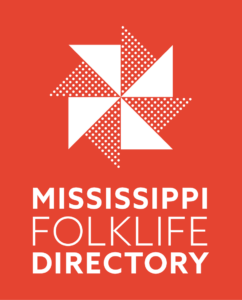About This Site
One of the central goals of the Mississippi Arts Commission (MAC) is to increase awareness of the state’s traditional art forms. As part of this work, MAC’s Folk and Traditional Arts Program documents musicians, artists, and other community-based art forms through the use of photography, audio, and video recording. The digital media created through this work are stored and archived in our Folklife Archive. While some of this material is shared with the public through programs and exhibits as well as in our online publication, Mississippi Folklife, the majority of it is not fully accessible to the public.
This website was created to help remedy this situation. With generous support from the National Endowment for the Arts, The Mississippi Folklife Directory provides access to a wide sampling of the materials in MAC’s Folklife Archive.
The directory consists of entries for artists, musicians, vernacular architecture sites, foodways, and folklife events. Each entry provides text, photos, contact information, and/or multimedia materials that present and document Mississippi’s traditional practices.
Entries are searchable by name, by six art genres: (Craft, Performance, Visual Art, Architecture, Foodways, and Folklife) and by the six geographic regions of Mississippi (the Appalachian Foothills, the Black Prairie, the Delta, the Gulf Coast, the Piney Woods, and the Red Clay Hills).
The Mississippi Folklife Directory is an ongoing project. New artists will be added and updates to the current pages will be made on a semi-regular basis. These changes will be noted on the home page. We plan for the site to grow and expand along with the work of the Folk and Traditional Arts Program, creating a comprehensive and readily accessible online archive of information on traditional expressive culture in Mississippi.
What are the Folk and Traditional Arts?
The folk and traditional arts are artistic expressions of community life. A community is a group of people held together by common bonds such as shared beliefs, language, identity, ethnicity, occupation, recreational interests, and regional affiliation. In short, folk arts often reflect the shared values, identity and aesthetics of a community.
Folk artists working within a community-based art form demonstrate a balance of individual creativity expressed within a collective arts tradition. Traditional artists usually learn informally through apprenticeships, imitation, and/or face-to face instruction, and folk arts are usually passed down from one generation to the next. There can be breaks in tradition when people migrate to new places or as a result of changing ways of life. Traditions adapt and grow over time, thus folk art can be a reflection of change and innovation as well.
Additional questions or comments, please contact:
Maria Zeringue, Folk and Traditional Arts Director
Mississippi Arts Commission
501 North West Street, Suite 1101A
Woolfolk Building
Jackson, MS 39201
(601) 359-6034
Site Credits:
Content (except where noted): Mississippi Arts Commission
Design: Southern Cult
